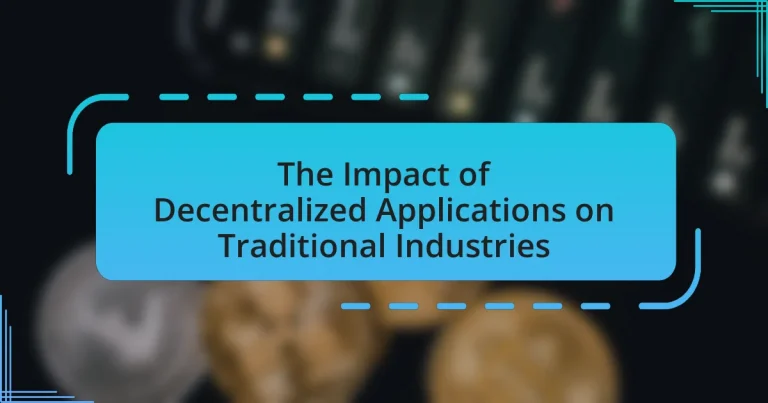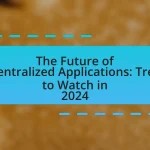Decentralized applications (dApps) are software applications that operate on blockchain or peer-to-peer networks, removing the need for central authorities. This article explores the transformative impact of dApps on traditional industries, highlighting their roles in enhancing transparency, security, and efficiency across sectors such as finance, supply chain management, and healthcare. Key technologies underpinning dApps, including blockchain and smart contracts, are discussed, along with the challenges faced by traditional systems that dApps can address. The article also examines future implications, emerging trends, and best practices for industries looking to integrate decentralized technologies.
What are Decentralized Applications and Their Role in Traditional Industries?
Decentralized applications (dApps) are software applications that run on a blockchain or peer-to-peer network, eliminating the need for a central authority. Their role in traditional industries includes enhancing transparency, improving security, and increasing efficiency by enabling direct peer-to-peer transactions without intermediaries. For instance, in supply chain management, dApps can provide real-time tracking of goods, ensuring authenticity and reducing fraud, as evidenced by companies like IBM using blockchain technology to enhance traceability. Additionally, in finance, dApps facilitate decentralized finance (DeFi), allowing users to lend, borrow, and trade without traditional banks, which can lower costs and increase access to financial services.
How do decentralized applications differ from traditional applications?
Decentralized applications (dApps) differ from traditional applications primarily in their architecture and control mechanisms. dApps operate on a decentralized network, typically utilizing blockchain technology, which allows for greater transparency, security, and resistance to censorship. In contrast, traditional applications are usually hosted on centralized servers, controlled by a single entity, which can lead to vulnerabilities such as data breaches and service outages. For example, Ethereum, a leading blockchain platform, enables the development of dApps that function without a central authority, thereby empowering users with more control over their data and interactions. This fundamental difference in structure and governance highlights the transformative potential of dApps in various industries.
What technologies underpin decentralized applications?
Decentralized applications (dApps) are primarily underpinned by blockchain technology, smart contracts, and peer-to-peer networking. Blockchain serves as the foundational technology, providing a distributed ledger that ensures transparency and security in transactions. Smart contracts, which are self-executing contracts with the terms directly written into code, automate processes and enforce agreements without intermediaries. Peer-to-peer networking facilitates direct interactions between users, enhancing decentralization by removing central authorities. These technologies collectively enable dApps to operate in a trustless environment, where users can engage without relying on a central entity, thus transforming traditional industries by increasing efficiency and reducing costs.
How do decentralized applications ensure security and transparency?
Decentralized applications ensure security and transparency through the use of blockchain technology, which provides a tamper-proof ledger of transactions. Each transaction is recorded in a block and linked to the previous block, creating a chain that is immutable and publicly accessible. This transparency allows all participants to verify transactions independently, reducing the risk of fraud. Additionally, decentralized applications often employ cryptographic techniques to secure data and user identities, ensuring that only authorized users can access sensitive information. The combination of these features makes decentralized applications inherently secure and transparent, as evidenced by the widespread adoption of blockchain in industries such as finance and supply chain management, where trust and verification are critical.
What challenges do traditional industries face that decentralized applications can address?
Traditional industries face challenges such as inefficiency, lack of transparency, high operational costs, and vulnerability to fraud, which decentralized applications can effectively address. Decentralized applications streamline processes by automating transactions through smart contracts, reducing the need for intermediaries and thus lowering costs. They enhance transparency by providing immutable records on a blockchain, allowing all stakeholders to verify transactions in real-time. Additionally, decentralized applications improve security against fraud by distributing data across a network, making it harder for malicious actors to manipulate information. For instance, the supply chain sector has seen improvements in traceability and accountability through decentralized solutions, leading to increased trust among consumers and partners.
How do inefficiencies in traditional systems impact businesses?
Inefficiencies in traditional systems negatively impact businesses by increasing operational costs and reducing productivity. For instance, outdated processes often lead to delays in decision-making and hinder effective communication, which can result in lost revenue opportunities. According to a study by McKinsey, companies that streamline their operations can reduce costs by up to 30%, highlighting the financial burden inefficiencies impose. Furthermore, traditional systems may struggle to adapt to market changes, causing businesses to miss out on innovations that could enhance their competitive edge.
What are the limitations of centralized systems in various industries?
Centralized systems in various industries face significant limitations, including single points of failure, lack of transparency, and reduced scalability. Single points of failure mean that if the central authority or server fails, the entire system can collapse, as seen in industries like finance where outages can halt transactions. Lack of transparency arises because centralized systems often restrict access to data, leading to trust issues among stakeholders, evident in supply chain management where visibility is crucial. Reduced scalability is another limitation, as centralized systems can struggle to handle increased loads, impacting performance during peak times, which is particularly problematic in sectors like e-commerce during high-demand periods. These limitations highlight the challenges that centralized systems encounter compared to decentralized alternatives.
How are Decentralized Applications Transforming Specific Traditional Industries?
Decentralized applications (dApps) are transforming traditional industries by enhancing transparency, reducing costs, and improving efficiency. In the finance sector, for example, dApps facilitate peer-to-peer transactions without intermediaries, significantly lowering transaction fees and processing times. According to a report by Deloitte, blockchain technology, which underpins many dApps, can reduce operational costs in banking by up to 30%.
In supply chain management, dApps provide real-time tracking of goods, ensuring authenticity and reducing fraud. A study by IBM found that 79% of executives believe that blockchain will disrupt their industry, highlighting the growing recognition of dApps’ potential.
In healthcare, dApps enable secure sharing of patient data, improving interoperability and patient outcomes. A report from Accenture indicates that blockchain could save the healthcare industry $150 billion annually by streamlining processes and reducing fraud.
Overall, dApps are reshaping traditional industries by leveraging decentralized technology to create more efficient, transparent, and cost-effective systems.
What impact do decentralized applications have on the finance industry?
Decentralized applications (dApps) significantly transform the finance industry by enabling peer-to-peer transactions without intermediaries. This shift reduces costs associated with traditional banking services, as dApps eliminate the need for third-party institutions, leading to lower transaction fees. For instance, platforms like Ethereum facilitate smart contracts that automate and enforce agreements, enhancing efficiency and transparency in financial transactions. Additionally, dApps promote financial inclusion by providing access to financial services for unbanked populations, as seen in projects like DeFi (Decentralized Finance) that allow users to lend, borrow, and trade assets without traditional banking infrastructure. The rise of dApps also introduces new regulatory challenges and necessitates the development of frameworks to ensure consumer protection and compliance.
How do decentralized finance (DeFi) platforms change traditional banking?
Decentralized finance (DeFi) platforms fundamentally alter traditional banking by eliminating intermediaries, enabling peer-to-peer transactions, and providing greater access to financial services. These platforms utilize blockchain technology to facilitate direct transactions between users, which reduces costs and increases transaction speed compared to traditional banking systems that rely on intermediaries like banks and payment processors. For instance, DeFi platforms can offer services such as lending, borrowing, and trading without the need for a central authority, allowing users to retain control over their assets. According to a report by the World Economic Forum, the DeFi market grew significantly in 2020, with total value locked in DeFi protocols reaching over $13 billion, demonstrating the shift in how financial services are accessed and utilized.
What are the risks and rewards of adopting DeFi solutions?
Adopting DeFi solutions presents both significant risks and rewards. The primary reward is the potential for high returns through yield farming and liquidity provision, which can offer annual percentage yields exceeding 100% in some cases, as evidenced by platforms like Aave and Compound. Conversely, the main risks include smart contract vulnerabilities, which have led to losses exceeding $1 billion in hacks and exploits in 2021 alone, according to a report by Chainalysis. Additionally, regulatory uncertainty poses a risk, as governments worldwide are still determining how to regulate DeFi, which could impact the legality and operation of these platforms.
How are decentralized applications influencing supply chain management?
Decentralized applications (dApps) are significantly influencing supply chain management by enhancing transparency, traceability, and efficiency. These applications utilize blockchain technology to create immutable records of transactions, allowing all parties in the supply chain to access real-time data. For instance, a study by the World Economic Forum highlights that blockchain can reduce supply chain fraud by up to 50% and improve inventory management by 20%. This increased transparency helps in tracking products from origin to consumer, thereby reducing delays and errors. Additionally, dApps facilitate smart contracts, which automate processes and reduce the need for intermediaries, further streamlining operations and cutting costs.
What benefits do decentralized applications bring to supply chain transparency?
Decentralized applications enhance supply chain transparency by providing immutable records of transactions and real-time data sharing among all stakeholders. This transparency reduces fraud and errors, as every transaction is recorded on a blockchain, making it easily verifiable. According to a study by the World Economic Forum, implementing blockchain technology in supply chains can reduce administrative costs by up to 30% and improve traceability, allowing companies to track products from origin to consumer. This level of transparency fosters trust among participants, leading to more efficient operations and better compliance with regulations.
How can decentralized applications improve traceability in supply chains?
Decentralized applications can improve traceability in supply chains by utilizing blockchain technology to create immutable records of transactions and product movements. This transparency allows all stakeholders, including manufacturers, suppliers, and consumers, to access real-time data about the origin, handling, and journey of products. For instance, a study by IBM and Maersk found that using blockchain for supply chain management can reduce the time spent on paperwork by up to 80%, thereby enhancing efficiency and accountability. This level of traceability not only helps in verifying the authenticity of products but also aids in quickly identifying and addressing issues such as recalls or fraud, ultimately leading to increased trust among consumers and partners in the supply chain.
What are the Future Implications of Decentralized Applications on Traditional Industries?
Decentralized applications (dApps) are poised to significantly disrupt traditional industries by enhancing transparency, reducing costs, and increasing efficiency. These applications leverage blockchain technology to eliminate intermediaries, which can streamline processes in sectors such as finance, supply chain, and healthcare. For instance, in finance, dApps can facilitate peer-to-peer transactions without the need for banks, potentially lowering transaction fees and increasing access to financial services. In supply chain management, dApps can provide real-time tracking of goods, improving accountability and reducing fraud. A report by Deloitte highlights that 40% of organizations are exploring blockchain solutions, indicating a strong trend towards adopting decentralized technologies. This shift could lead to a reconfiguration of business models, where traditional companies may need to adapt or risk obsolescence.
How might decentralized applications evolve in the coming years?
Decentralized applications (dApps) are likely to evolve by becoming more user-friendly, scalable, and integrated with traditional systems. As blockchain technology matures, developers will focus on enhancing the user experience, making dApps more accessible to non-technical users. For instance, advancements in layer-2 solutions, such as Optimistic Rollups and zk-Rollups, will improve transaction speeds and reduce costs, addressing scalability issues that currently hinder widespread adoption. Furthermore, the integration of dApps with existing industries, such as finance and supply chain, will facilitate hybrid models that leverage both decentralized and centralized systems, thereby increasing their utility and acceptance. The growing regulatory clarity around blockchain technology will also encourage more businesses to adopt dApps, leading to a broader range of applications across various sectors.
What trends are emerging in the adoption of decentralized applications?
Emerging trends in the adoption of decentralized applications include increased integration with traditional industries, a focus on user privacy and data ownership, and the rise of decentralized finance (DeFi) solutions. Traditional industries are increasingly exploring decentralized applications to enhance transparency and efficiency, as evidenced by major companies like IBM and Microsoft investing in blockchain technology. Additionally, user privacy concerns are driving demand for applications that allow individuals to control their data, leading to the development of platforms that prioritize decentralized identity solutions. The DeFi sector is also experiencing rapid growth, with the total value locked in DeFi protocols surpassing $80 billion in 2021, indicating a significant shift towards decentralized financial services.
How can traditional industries prepare for the integration of decentralized technologies?
Traditional industries can prepare for the integration of decentralized technologies by investing in education and training for their workforce. This approach ensures that employees understand the principles and applications of decentralized systems, such as blockchain and smart contracts. For instance, a study by the World Economic Forum indicates that 10% of global GDP could be stored on blockchain by 2027, highlighting the importance of adapting to these technologies. Additionally, traditional industries should collaborate with technology providers to pilot decentralized solutions, allowing them to assess the benefits and challenges in real-world scenarios. This proactive strategy positions them to leverage the efficiencies and transparency that decentralized technologies offer, ultimately enhancing their competitiveness in the market.
What best practices should industries follow when implementing decentralized applications?
Industries should prioritize security, scalability, and user experience when implementing decentralized applications. Security is crucial due to the immutable nature of blockchain technology, which makes vulnerabilities potentially catastrophic; thus, conducting thorough audits and employing best practices in cryptography is essential. Scalability must be addressed to ensure that the application can handle increased loads without performance degradation; this can be achieved by utilizing layer-2 solutions or optimizing smart contracts. Lastly, focusing on user experience is vital, as user adoption hinges on intuitive interfaces and seamless interactions; industries should invest in user research and design to create applications that meet user needs effectively.
How can organizations assess their readiness for decentralized application adoption?
Organizations can assess their readiness for decentralized application adoption by evaluating their existing technological infrastructure, workforce skills, and organizational culture. A thorough analysis of current systems reveals whether they can support decentralized technologies, such as blockchain or distributed ledgers. Additionally, assessing workforce skills ensures that employees possess the necessary technical knowledge and adaptability to work with decentralized applications. Finally, examining organizational culture helps determine if there is a willingness to embrace innovation and change, which is crucial for successful adoption. This multi-faceted approach provides a comprehensive understanding of readiness, enabling organizations to identify gaps and areas for improvement before implementation.
What strategies can help mitigate risks associated with decentralized applications?
Implementing robust security protocols is essential to mitigate risks associated with decentralized applications. These protocols include regular security audits, which help identify vulnerabilities in the code, and the use of formal verification methods to mathematically prove the correctness of smart contracts. Additionally, employing multi-signature wallets can enhance security by requiring multiple approvals for transactions, thereby reducing the risk of unauthorized access. According to a report by the Blockchain Security Alliance, 70% of vulnerabilities in decentralized applications stem from coding errors, underscoring the importance of thorough testing and auditing processes. Furthermore, educating users about potential risks and best practices can significantly reduce the likelihood of phishing attacks and other security breaches.





